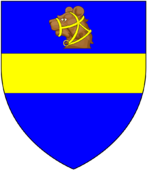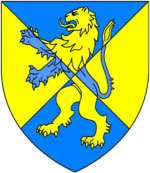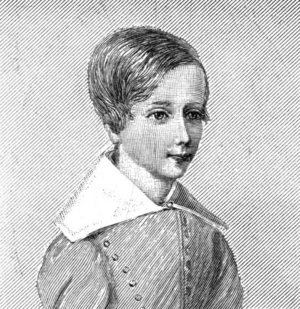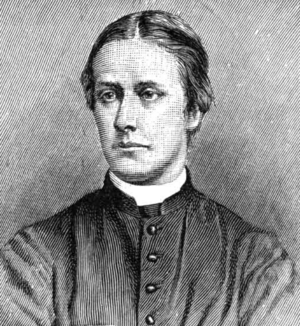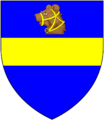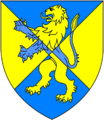Sabine Baring-Gould facts for kids
Quick facts for kids
Sabine Baring-Gould
|
|
|---|---|
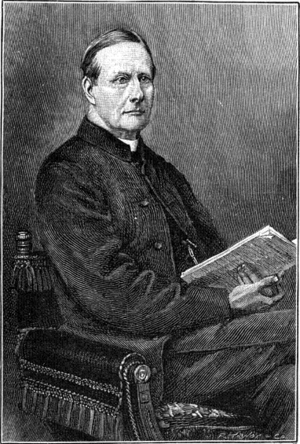
Sabine Baring-Gould, engraving published in Strand Magazine, from a photograph by Downey (died 1881)
|
|
| Born |
p
28 January 1834 St Sidwells, Exeter, England
|
| Died | 2 January 1924 (aged 89) Lew Trenchard, Devon, England
|
| Nationality | British |
| Alma mater | Clare College, Cambridge |
| Occupation | Anglican priest, hagiographer, antiquarian, novelist, folk song collector and eclectic scholar |
Sabine Baring-Gould (born January 28, 1834 – died January 2, 1924) was a very busy and talented English writer and priest. He lived in Lew Trenchard in Devon, England. He was an Anglican priest, a writer of saints' lives (a hagiographer), someone who studied old things (an antiquarian), a novelist, and a collector of folk songs. He wrote over 1,240 books and articles!
He is best known for writing famous hymns like "Onward, Christian Soldiers" and "Now the Day Is Over". He also translated carols such as "Gabriel's Message" from the Basque language into English.
His family home, the manor house of Lew Trenchard, is now a hotel. It has been kept just as he rebuilt it.
Contents
Early Life and Family
Sabine Baring-Gould was born in St Sidwells, Exeter, on January 28, 1834. He was the oldest son of Edward Baring-Gould. His father was the lord of the manor of Lew Trenchard. He was also a Justice of the Peace and a Deputy Lieutenant of Devon.
Sabine's family was quite old and important. His grandfather, William Baring, added "Gould" to his name in 1795. This was because he inherited the Lew Trenchard estate from his mother, Margaret Gould. The Gould family had a long history, going back to a crusader in 1217!
The Baring family was also well-known. Two of Sabine's great-uncles, Francis and John Baring, started a famous London business. This company later became Barings Bank. Sabine was named after his grandmother's family, the Sabines. Her brother was the Arctic explorer General Sir Edward Sabine.
Education and Early Career
Sabine's family traveled a lot around Europe when he was a child. Because of this, he was mostly taught by private teachers at home. He only went to formal schools for about two years. He attended King's College School in London and then Warwick School. He had to leave Warwick School because of a lung illness. His father thought more travel in Europe would help him get better.
In 1852, he started studying at Cambridge University. He earned his first degree in 1857 and a master's degree in 1860 from Clare College, Cambridge. After college, he taught at two boys' boarding schools in Sussex. He taught many subjects, including languages and science. He even helped design parts of the school library.
In 1864, at age 30, he became a curate (a type of assistant priest) in Horbury Bridge, West Riding of Yorkshire. There, he met Grace Taylor, who was 14 years old and the daughter of a mill worker. They fell in love. To prepare Grace for marriage into his family, his vicar arranged for her to live with relatives in York for two years. She learned middle-class manners there.
Sabine and Grace got married in 1868. They were married for 48 years and had 15 children. Almost all of their children lived to be adults. When Grace died in 1916, Sabine had a special message carved on her tombstone: Dimidium Animae Meae, which means "Half my Soul" in Latin.
In 1871, Baring-Gould became the rector of East Mersea in Essex. He stayed there for ten years. In 1872, his father passed away, and Sabine inherited the family estates in Lewtrenchard, Devon. These estates were about 3,000 acres. This inheritance also meant he could choose the new priest for Lew Trenchard parish. When the position became open in 1881, he appointed himself! So, he became both the parson (priest) and the squire (landowner) of the village. He worked hard to restore St Peter's Church in Lew Trenchard. He also completely changed his home, Lew Trenchard Manor, between 1883 and 1914.
Collecting Folk Songs
Sabine Baring-Gould believed that collecting folk songs was one of his most important achievements. He gathered these songs with the help of ordinary people in Cornwall and Devon. His first book of songs was called Songs and Ballads of the West. It was published in four parts between 1889 and 1891.
He worked with other musicians to publish these songs. Later, in 1905, a new edition of Songs of the West was planned. Since his first musical editor had passed away, another famous folk song collector, Cecil Sharp, helped with the music. Baring-Gould and Sharp also worked together on English Folk Songs for Schools in 1907. This book of 53 songs was used in British schools for 60 years!
Even though he sometimes had to change the words of songs that were too "rude" for his time, he saved his original notes. This helped future students of folk music. Thanks to him, many beautiful songs and their words were not lost forever.
He gave his collected folk songs and notebooks to Plymouth Public Library in 1914. Today, you can find many of his folk song writings online. Cecil Sharp even dedicated his book English Folk Song: Some Conclusions (1907) to Baring-Gould.
His Writings
Baring-Gould wrote many novels. Some of his well-known stories include The Broom-Squire (1896) and Mehalah: a story of the salt marshes (1880). He also wrote a huge 16-volume collection called The Lives of the Saints. He wrote a biography about the interesting poet-vicar of Morwenstow, Robert Stephen Hawker.
He published almost 200 short stories in different magazines. Many of these were later put together into books, like his Book of Ghosts (1904). He also wrote The Book of Were-Wolves (1865), which is a famous study of stories about werewolves. He liked to write while standing up. His special standing desk can still be seen in his manor house.
One of his most popular books was Curious Myths of the Middle Ages. It was first published in 1866 and 1868. This book explores different medieval superstitions and their origins. The famous writer H. P. Lovecraft called it "that curious body of medieval lore."
He wrote a lot about the West Country region of England. Some of these books include:
- A Book of the West (1899), which covered Devon and Cornwall.
- Cornish Characters and Strange Events (1909).
- Devonshire Characters and Strange Events.
Baring-Gould was also the president of the Royal Institution of Cornwall for ten years, starting in 1897.
Exploring Dartmoor
Sabine Baring-Gould was also interested in archaeology. With his friend Robert Burnard, he led the first scientific digs of ancient hut-circles on Dartmoor. This happened at Grimspound in 1893. They then formed a group called the Committee of the Devonshire Association for the exploration of Dartmoor.
Baring-Gould was the secretary of this committee and wrote its first ten annual reports until 1905. This group did many archaeological digs of old settlements on Dartmoor. They carefully recorded and sometimes even restored ancient stone rows and stone circles. Much of what we see of these prehistoric sites on Dartmoor today is thanks to the work of Sabine Baring-Gould and his team. He was also president of the Devonshire Association in 1896.
He wrote several books about Dartmoor, including:
- Dartmoor idylls (1896)
- A Book of Dartmoor (1900)
His Family and Legacy
Sabine Baring-Gould married Grace Taylor on May 25, 1868. They had 15 children: Mary, Margaret Daisy, Edward Sabine, Beatrice Gracieuse, Veronica, Julian, William Drake, Barbara, Diana Amelia, Felicitas, Henry, Joan, Cecily Sophia, John Hillary, and Grace. Sadly, Beatrice died when she was only two years old.
His wife Grace passed away in April 1916. Sabine did not marry again. He died on January 2, 1924, at his home in Lew Trenchard. He was buried next to his wife.
He wrote two books about his own life: Early Reminiscences, 1834–1864 (1923) and Further Reminiscences, 1864–1894 (1925).
One of his grandsons, William Stuart Baring-Gould, was a famous expert on Sherlock Holmes. He even wrote a made-up biography of Sherlock Holmes. To fill in the missing parts of Holmes's early life, he based them on Sabine Baring-Gould's childhood! Sabine himself is a main character in the Sherlock Holmes novel The Moor by Laurie R. King. In this book, it is said that Sabine Baring-Gould was Sherlock Holmes's godfather.
Another of his grandsons was the radio actor Robert Burnard. The comedian Josh Widdicombe is also a distant relative of Sabine Baring-Gould.
List of Works
- A Book of the Pyrenees (1907)
- Court Royal (1891)
- A Book of Dartmoor (1900)
- A Book of North Wales (1903)
- Amazing Adventures, illustrated by Harry B. Neilson (1903)
- A Book of Ghosts (1904)
- A Book of South Wales (1905)
- A Book of the Rhine from Cleve to Mainz (1906)
- A Book of the West: Being an Introduction to Devon and Cornwall (2 Volumes, 1899)
- An Old English Home and its Dependencies (1898)
- Arminell
- Bladys of the Stewponey (1919)
- Cliff Castles and Cave Dwellings of Europe
- Cheap Jack Zita (1896)
- Cornish Characters (1909)
- Curiosities of Olden Times (1896)
- Curious Myths of the Middle Ages (1866)
- Dartmoor Idylls (1896)
- Devon (1907)
- Devon Characters and Strange Events (1908)
- Domitia (1898)
- Eve
- Family Names and their story (1910)
- Grettir the Outlaw: a story of Iceland (1890)
- Iceland, Its Scenes and Its Sagas
- In Dewisland (1904)
- In the Roar of the Sea (1891)
- In Troubadour Land: A Ramble in Provence and Languedoc (1890)
- John Herring
- Lives of the Saints, in sixteen volumes (1897)
- Legends of the Patriarchs and Prophets
- Mehalah, A Story of the Salt Marshes (1880)
- Noemi
- Old Country Life (1889)
- Pabo, The Priest (1899)
- Red Spider (1887)
- Richard Cable (1888)
- Songs of the West: Folksongs of Devon & Cornwall (1905)
- The Book of Were-Wolves, being an account of a terrible superstition (1865)
- The Broom-Squire (1896)
- The Gaverocks
- The Life of Napoleon Bonaparte (1908)
- The Lives of the Saints – a sixteen-volume collection (1872 and 1877)
- The Mystery of Suffering
- The Pennycomequicks
- The Tragedy of the Caesars (1892)
- Troubadour-Land: A Ramble in Provence and Languedoc (1891)
- The Vicar of Morwenstow, being a life of Robert Stephen Hawker (1876)
- Urith
Images for kids


